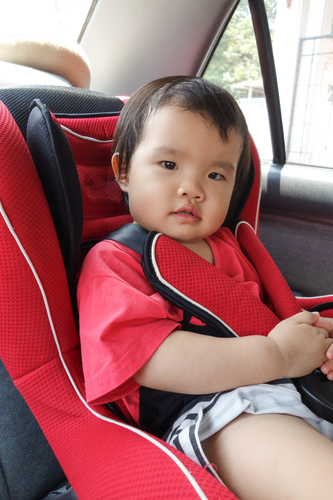Car Seat Safety Tips
At some point in time, every parent must deal with the often daunting tasks of purchasing and installing a car seat. In the last year, the American Academy of Pediatrics altered its recommendations regarding car seat safety, with the most notable change of having all children sit rear facing until the age of two. Car seat safety is an important part of the anticipatory guidance offered by your pediatrician, and this article will hopefully provide some helpful tips.

Infants
All infants should ride in a REAR facing car seat until the age of 2 or until they exceed the height and weight requirements delineated by the manufacturer. There are three types of rear facing car seats.
Rear facing only seats are the seats that typically have a stationary base placed in the car and a removable seat with a handle for carrying. These seats cannot be turned forward at any point
Convertible car seats are ones that can accommodate both a rear facing and later forward facing child. These seats have a wider height and length range than rear facing only seats. These seats will have a 5-point harness strap that can be adjusted as the child grows
3-in-1 seats are designed to be rear facing, forward facing, and later on, a belt-positioning booster seats. These seats will afford the most use, as they can be used from infancy through school age children.
Toddlers and Pre-school aged children
Children in this age group can be placed forward facing after the age of 2, or when they outgrow the rear facing specifications of your car seat. Ideally children should be in a car seat with a 5-point harness for as long as they can, at least until 4 years old. There are different types of forward facing seats, including the above mentioned convertible and 3-in-1 seats. Some newer cars even have built-in forward facing seats.
School aged children
School aged children who have outgrown the parameters of a 5-point harness forward facing seat may sit in a booster seat. These seats are designed to elevate the child on the seat so that the lap belt and shoulder harness fit properly. This is typically when a child is at least 4 feet 9 inches (57 inches) tall and between 8 to 12 years old. There are belt-positioning boosters as well as high-backed and backless boosters. In any of these booster seats, the lap portion of the seat belt should lie low and snug across the child’s thighs while the harness crosses the middle of the chest and shoulder.
In New Jersey, the law requires that a child be placed in a booster seat in the rear seat until they are 8 years old or 80 pounds. The federal governmental guidelines stress that weight does not affect the safety of the car seat, and that children should be in a booster seat until they reach 57 inches. Following this recommendation of height will keep a child in a booster seat until they are 11 or 12 years old rather than 8.
Older children
Older children may sit directly on the vehicle’s seat when they no longer require a booster seat for the seat belt to fit properly. This is generally at a height greater than 4 feet 9 inches (57 inches). The seat belt fits properly when:
The shoulder belt lies across the middle of the chest and shoulder, not the neck or throat.
The lap belt is low and snug across the upper thighs, not the belly.
Your child is tall enough to sit against the vehicle seat back with his or her knees bent without slouching and can stay in this position comfortably throughout the trip.
New Jersey State law requires that all passengers from 8 to 18 years old wear a seatbelt when traveling in a moving vehicle. Although there is no written state law regarding sitting in the front seat, New Jersey recommends that children under the age of 12 not sit in the front seat. The American Academy of Pediatrics recommends that all children younger than 13 years be restrained in the rear seats of vehicles for optimal protection. These recommendations are made to ensure the safety of young children if an air bag were to deploy in an accident.
You should decide on a car seat that will best meet your needs and will fit well in your vehicle. You should never use a seat that has been in any type of accident. Make sure that if you are using an older car seat, it has not been recalled and that you are not using it for longer than the manufacturer recommends. Always remember to check your manufacturer’s manual to ensure that your car seat is installed safely and properly in your vehicle. If you have any concern or question on how to install your seat you can also search for a certified Child Passenger Safety Technician (CPST) in your area who can help.
Here are some helpful websites:
National Highway Traffic Safety Administration www.nhtsa.gov
SeatCheck.org www.seatcheck.org
To find a CPST cert.safekids.org
The Insurance Institute for Highway Safety www.iihs.org
Featured Blogger
Leslie Greenberg

Leslie Greenberg, MD, FAAP is a general pediatrician practicing with Princeton Nassau Pediatrics. She graduated from Brandeis University magna cum laude with a BA in sociology. She attended medical school at Tufts University School of Medicine and completed her residency training at The Children's Hospital of Montefiore in the Bronx, NY. She currently lives in the West Windsor, NJ area with her husband and two sons. She has been with PNP since 2009. Princeton Nassuau Pediatrics is a group of board certified general pediatricians whose mission is providing the highest level of health care to the children of the greater Princeton, West Windsor, Monroe, and Pennington areas. The group provides state of the art care for children from infancy through college based on the most up-to-date medical advances. PNP has four locations, and offers routine well care visits, same day sick visits, weekend/holiday and evening urgent care coverage, as well as full in-office laboratory services. Visit www.princetonnassaupediatrics.com.























